Matthew S. Williams's Blog, page 46
July 8, 2014
Space Tourism: World View Balloon Aces First Test
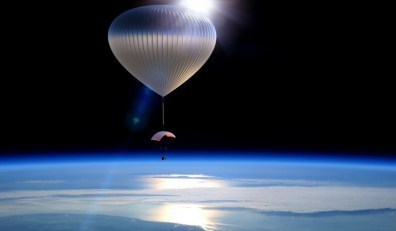 Late last year, a new space tourism company emerged that proposed using a high-tech balloon ride to take passengers higher than they’ve ever been. The company quickly earned FAA approval for its audacious plan to take tourists on five hour near-space rides. And late last month, the company successfully completed its first round of tests, and in the process broke the record for the highest parafoil flight.
Late last year, a new space tourism company emerged that proposed using a high-tech balloon ride to take passengers higher than they’ve ever been. The company quickly earned FAA approval for its audacious plan to take tourists on five hour near-space rides. And late last month, the company successfully completed its first round of tests, and in the process broke the record for the highest parafoil flight.
The company launched the test flight some three weeks ago from Roswell, New Mexico using a balloon which was roughly one third the size of that planned for passengers flight. It carried a payload of about 204 kg (450 lb), which is one-tenth the weight of what the company expects will be a full passenger load. The flight was the first time all the components were tested together, reaching a record-breaking altitude of 36,500 m (120,000 ft).
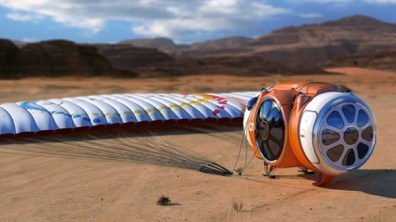 Though components of the experience have been tested in the past, this marks the first time all elements of the spaceflight system were tested together. It was a huge success and a major milestone for the company. The company hopes to be able to commence passenger rides by 2016, once they’ve completed all testing to make sure their equipment and methods are safe.
Though components of the experience have been tested in the past, this marks the first time all elements of the spaceflight system were tested together. It was a huge success and a major milestone for the company. The company hopes to be able to commence passenger rides by 2016, once they’ve completed all testing to make sure their equipment and methods are safe.
Based on their FAA filings, the company has said that it will launch its rides from Spaceport American in the New Mexican desert. However, CEO Jane Poynter has recently said that no final decision has actually been made in this regard. Although the balloon does not technically lift its passengers into outer space – which is defined as a distance of 100 km (62 miles) from the Earth’s surface – it will certainly make for an unforgettable experience.
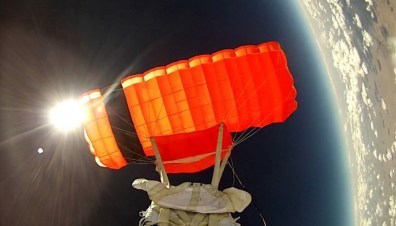 For the cost of $75,000, customers will be taken to an altitude of 32 km (20 miles). From there, they will be able to see the curvature of the Earth, and at a fraction of the price for Virgin Galactic’s $200,000 rocket-propelled trip. The ride will consist of a capsule large enough for passengers to walk around in will being lifted well above the troposphere, thanks to a giant balloon containing 400,000 cubic meters of helium.
For the cost of $75,000, customers will be taken to an altitude of 32 km (20 miles). From there, they will be able to see the curvature of the Earth, and at a fraction of the price for Virgin Galactic’s $200,000 rocket-propelled trip. The ride will consist of a capsule large enough for passengers to walk around in will being lifted well above the troposphere, thanks to a giant balloon containing 400,000 cubic meters of helium.
Their space balloon is not at all dissimilar to the one used by daredevil Felix Baumgartner when he broke the record for high-altitude skydiving roughly two years ago. In order to return back to Earth, the balloon will cut away from the capsule, and then a parafoil will allow it to land safely as a paraglider, deploying skids on which to land. Alongside other space-tourism ventures, the latter half of this decade is likely to be an exciting time to be alive!
Be sure to check out the company’s website by clicking here. And in the meantime, enjoy this company video showing the test flight:
Source: gizmag.com, worldviewexperience.com


Oscar Mike – Chapter Two
In such dangerous things as war the errors which proceed from a spirit of benevolence are the worst.
-General Karl von Clausewitz
A single, piercing light shone from the roof. A series of relief maps were spread across the table. And all around, the noise of reports coming through on the vehicles many comms. Standing in the open hatch, Haynes listened to it all as he peered to the horizon. Daylight was beginning to break over his troop’s positions, those that were camped out in the fields and the rest that were busily advancing their way towards their objectives.
And they were his troops now. He took great joy in that thought. After being fractured and confused during the course of their withdrawal, they were once again moving as one, confident in themselves as well as their commander. And every way he looked, he could spot elements that were on the move.
To the west, Second Battalion was making its way along the route into the left bank of town. To the east, First Battalion – his old command – was moving into the township of Sombrillo and sweeping for incursions. In the center, directly north of his command post, was the Battalion Combat Team, who’s armored columns rolled along the highway like a metal fist, driving straight into the heart of the engagement.
He could hear the faints pops of rifle and MG fire. Here and there, troops were reporting contacts with Whiskeys and taking them out. Before and after each sound, the comms would come alive with the report of “contact”, followed shortly thereafter with a “tango down”. Another thing he took joy in, the tightening of discipline that was evident in the action reports. Yes, there was little they could not accomplish when they simply followed orders!
That last thought disturbed his buoyant mood. Despite the absence of the former Lieutenant, he still had many troublemakers to contend with. For the life of him, he could not understand why Thur had trusted them to the extent he had. But then again, sentimentality was a particular soft spot for that man. How he should have known better. Such things simply weren’t useful or safe in the world they now inhabited.
But he dared not think of such things now. Not when the man was still straddling the fine line between life and death. The best he could do now was to try and fulfill his role and maintain the command, for as long as he held it. To do any less would be worse than dereliction, it would be weakness.
He raised the binoculars again and scanned to the east. In the township of Sombrillo, which resembled a medieval-walled city from this distance, he could see units from Second’s Charlie Company moving about. Finished with targeting Whiskeys in the streets, they now began searching from house to house, alerting the residents of their arrival and inviting them to declare themselves.
In certain cases, where no one was to be found; or worse, Whiskeys had found there way in, things went a little differently. Here and there, he could see muzzle flashes in the windows, illuminating the interiors and signalling the death of another infected. Never more than a few shots were fired from house to house, and then the troopers responsible appeared in the doorway and moved onto the next house.
Like finely tuned clockwork. And the reports kept coming in. It wasn’t long before the Company CO called it in, declaring that the town had been cleared of hostiles, giving a head count on how survivors they had found and many infected they’d killed. From the command vehicle, Captain Dubrovinsky relayed it to him.
“General, C-Company, 2nd Battalion reporting from objective area. Two-hundred plus survivors, two dozen Whiskeys down.”
“Excellent, Captain,” he replied. “Order C-Company to secure area and hold position until further orders. Dispatch medical crews to inspect survivors.”
“Yes, sir. Relaying orders now.”
Haynes went back to surveying the scene as his underlings carried out their orders. By now, the BCT and First Battalion was entering the heart of Espanola, moving from the US 84 onto the town’s main strip that ran north along the river. He could recall the last time they had pushed up this way, just a few weeks previous; back when the enemy had been something other than the lumbering ghouls they knew as the Whiskeys. That enemy had been somewhat more stubborn in their resistance, but even they had been forced to retreat when the hordes had closed in on the valley from all sides…
What followed was something he would be happy to forget. His first time at the helm, and he had been forced to order a general retreat. They were within a hair’s reach of total victory, of defeating the regular Army forces that had hit them just that morning and retaking every inch of the town. How quickly victory had turned into defeat! But that didn’t matter now. Not when they were in the process of righting that wrong.
Amidst the squat structures and trees that dotted the township, it became harder to see his armored vehicles and troop carriers as they fanned out to take their objectives. But he could sense them at work, and could hear from the unending trickle of reports how they were fairing.
One by one, the designated zones were declared clear after some sporadic fire.
“Zulu Romeo Sierra clear.”
“Zulu Sierra Charle clear.”
“X-ray Romeo Foxtrot -”
The last report was clipped as the sound of a loud shriek cut across the landscape. Haynes caught sight of a fireball in the distance and heard the loud thunderclap that followed. He quickly raised his binoculars, but could see little other than a raging fire and plume of black smoke. He caught minor glimpses of his troops running about and the vehicles pulling madly away from the highway. But no indications of what had happened. The reports coming in behind him were more clear, but not at all encouraging.
“-blue on blue! I say again, we have blue on blue with un-ID’d unit! Please advise!”
Dubrovinsky was hurriedly asking for clarification as Haynes came to the back door. He looked from the Captain to Lieutenant Walker, who pouring over their maps. All he got from the latter was a confused look, and an equally confused report from the Captain once he was finished on the horn.
“General, Battalion Combat Team is reporting friendly fire along State Road 68.”
“We have no units in that area, sir!” the Lieutenant said, objectionably. “This can’t be a case of blue on blue.”
“How do I advise, General?”
Haynes face drew into a tight frown and he felt like spitting. His mouth formed the words, “son of a bitch”. The Captain was busy repeated his request for instructions when Haynes grabbed the mike from him.
“Bushmaster One, this is Rattlesnake Actual. What is the location of the enemy fire team, over?”
The BCT Commander was a second in coming back. Hearing that the fire was coming from an enemy team clearly caused him a moment’s pause. When he replied, he sounded rather irate. “Rattlesnake Actual, the fire team is located on the roof of the pharmacy building overlooking objective X-Ray Romeo Foxtrot. Enemy appears to be using Alpha Tango Fours and has taken out a Mike One-Zero-One Bravo.”
“Shit,” Haynes lowered the mike and looked back in the direction of town. He could see the black smoke rising, and heard the multiple reports of gunfire erupting from several positions. Aside from being a main objective, the intersection where the fighting was now going down was the key to retaking Espanola – the point where it’s east-west axis crossed the main north-south running road. And the enemy had not only managed to hold it amidst the Whiskey incursion, but was now defending it.
He keyed the mike again. “Bushmaster One, you have made contact with elements hostile to our forces. Pull your team back and regroup and prepare for fire mission.”
The BCT commander replied a second later. “Roger that, Rattlesnake Actual. Combat Team pulling back.”
Haynes handed the mike back to Dubrovinsky and pointed his finger in the man’s face. “Captain, get on the horn with the one-hundred and fiftieth. Tell the Colonel we need a Spectre on station to provide air support immediately.”
“General, what about the fuel situation?”
“Fuel discipline will have to be lifted for the time being,” he said unhappily. “Now raise Iswolski now and relay the following coordinates.”
The Captain nodded obligingly and jotted down the numbers given to him. Haynes knew he was right. After all the materiel losses they’d suffered in the past few weeks, they simply couldn’t afford to be putting birds in the air right now. But he would be damned if the traitorous fuckers from back east would stall his operation any longer. And he was not about to risk the lives of any more personnel to dislodge them.
The Captain handed the mike to the General a moment later. From their airbase in Santa FE, The voice of Colonel Iswolski streamed through the radio box.
“Roger that, Rattlesnake Actual. We have an Alpha Charlies One-Thirty prepping now and will airborne in five mikes.”
Haynes nodded, feeling a sense of calm reassurance once again. He looked in the direction of town once more. Within minutes, they could forward to some air support and the main column of their advance could get moving again. Meanwhile, if any more enemy troops turned up, they would have some serious firepower on station to provide overwatch and a decisive edge. None of the bastards would survive!
In the meantime, First and Second continues in their advance east and west of the main strip. In time, he expected they would be able to account for all the outlying districts and those people still huddled in their homes. And if luck was on their side, and there were few pockets of human resistance to speak of left, they would have the town secured by the afternoon.
All that was needed was no more surprises…


July 7, 2014
The Future is Here: Overcoming Paralysis
 Ian Burkhart, a 23-year-old quadriplegic from Dublin, Ohio, was injured in 2010 in a diving accident, breaking his neck on a sandbar and paralyzing his body from the neck down. He was left with some use of his arms, but lost the use of his legs, hands, and fingers. Thanks to a new device known as the Neurobridge though – a device that allows the brains signals to bypass the severed spinal cord – Burkhart has now moved his right hand and fingers for the first time since the accident.
Ian Burkhart, a 23-year-old quadriplegic from Dublin, Ohio, was injured in 2010 in a diving accident, breaking his neck on a sandbar and paralyzing his body from the neck down. He was left with some use of his arms, but lost the use of his legs, hands, and fingers. Thanks to a new device known as the Neurobridge though – a device that allows the brains signals to bypass the severed spinal cord – Burkhart has now moved his right hand and fingers for the first time since the accident.
This device, which was developed in concert by the Ohio State University Wexner Medical Center and the non-profit company Battelle, consists of a pea-sized chip that contains an an array of 96 electrodes, allows researchers to look at detailed signals and neural activity emanating from the patient’s brain. This chip was implanted in Ian’s brain two months ago, when neurosurgeon Dr Ali Rezai of Ohio State University performed the surgery that would implant the sensor chip into the motor cortex of his brain.
 Battelle has been working on neurosensing technology for almost a decade. As Chad Bouton, the leader of the Neurobridge project at Battelle, explains:
Battelle has been working on neurosensing technology for almost a decade. As Chad Bouton, the leader of the Neurobridge project at Battelle, explains:
We were having such success in decoding brain activity, we thought, ‘Let’s see if we could remap the signals, go around something like a spinal cord injury and then translate the signals into something that the muscles could understand and help someone paralyzed regain control of their limb’.
During the test, which occurred in June, the implanted chip read and interpreted the electrical activity in Burkhart’s brain and sent it to a computer. The computer then recoded the signal, and sent it to a high-definition electrode stimulation sleeve Burkhart wore on his right arm, a process that took less than a tenth of a second and allowed Burkhart to move his paralysed fingers. Basically, Burkhart is able to move his hand by simply thinking about moving his hand, and the machine does the rest.
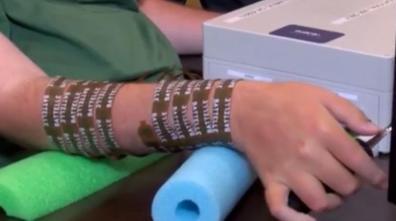 A team led by Chad Bouton at Battelle spent nearly a decade developing the algorithms, software and sleeve. Then, just two years ago, Dr Ali Rezai and Dr Jerry Mysiw were brought on board to design the clinical trials. Burkhart became involved with the study after his doctor mentioned it to him and he learned he was an ideal candidate. He had the exact level of injury the researchers were looking for, is young and otherwise healthy, and lives close to the Ohio State University Wexner Medical Center, where the research is being conducted.
A team led by Chad Bouton at Battelle spent nearly a decade developing the algorithms, software and sleeve. Then, just two years ago, Dr Ali Rezai and Dr Jerry Mysiw were brought on board to design the clinical trials. Burkhart became involved with the study after his doctor mentioned it to him and he learned he was an ideal candidate. He had the exact level of injury the researchers were looking for, is young and otherwise healthy, and lives close to the Ohio State University Wexner Medical Center, where the research is being conducted.
Even so, Burkhart had to think hard before agreeing to the surgery. He also knew that the surgery wouldn’t magically give him movement again. He would have to undergo rigorous training to regain even basic hand function. Mainly, his experience would help move along future technological advances. However, he was excited to be taking part in cutting-edge research which would ultimately help people like him who have suffered from spinal injuries and paralysis.
 Post-surgery, Burkhart still had a lot of thinking to do, this time, in order to move his hand. As he explained:
Post-surgery, Burkhart still had a lot of thinking to do, this time, in order to move his hand. As he explained:
It’s definitely great for me to be as young as I am when I was injured because the advancements in science and technology are growing rapidly and they’re only going to continue to increase… Mainly, it was just the fact that I would have to have brain surgery for something that wasn’t needed… Anyone able bodied doesn’t think about moving their hand, it just happens. I had to do lots of training and coaching.
The hand can make innumerable complex movements with the wrist, the fingers, and the fist. In order for Battelle’s software to read Ian’s mind, it has to look for subtle changes in the signals coming from Ian’s brain. As Bouton explains it, the process is like walking into a crowded room with hundreds of people trying to talk to each other, and you’re trying to isolate one particular conversation in a language that you don’t understand.
 At this point, Burkhart can perform a handful of movement patterns, including moving his hand up and down, opening and closing it, rotating it, and drumming on a table with his fingers. All of this can only be done while he’s in the hospital, hooked up to the researchers’ equipment. But the ultimate goal is to create a device and a software package that he can take with him, giving him the ability to bypass his injury and have full ambulatory ability during everyday activities.
At this point, Burkhart can perform a handful of movement patterns, including moving his hand up and down, opening and closing it, rotating it, and drumming on a table with his fingers. All of this can only be done while he’s in the hospital, hooked up to the researchers’ equipment. But the ultimate goal is to create a device and a software package that he can take with him, giving him the ability to bypass his injury and have full ambulatory ability during everyday activities.
This isn’t the only research looking into bringing movement back to the paralyzed. In the past, paralyzed patients have been given brain-computer interfaces, but they have only been able to control artificial limbs – i.e. Zak Water’s mind-controlled leg or the BrainGate’s device that allow stroke victims to eat and drink using a mind-controlled robotic arm. Participants in an epidural stimulator implant study have also been able to regain some movement in their limbs, but this technology works best on patients with incomplete spinal cord injuries.
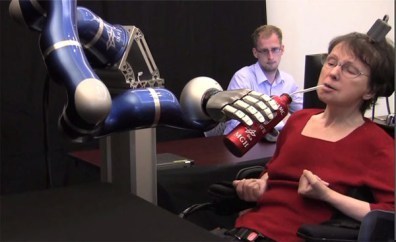 Burkhart is confident that he can regain even more movement back from his hand, and the researchers are approved to try the technology out on four more patients. Ultimately, the system will only be workable commercially with a wireless neural implant, or an EEG headset – like the Emotiv, Insight or Neurosky headsets. The technology is also being considered for stroke rehabilitation as well, another area where EEG and mind-control technology are being considered as a mean to recovery.
Burkhart is confident that he can regain even more movement back from his hand, and the researchers are approved to try the technology out on four more patients. Ultimately, the system will only be workable commercially with a wireless neural implant, or an EEG headset – like the Emotiv, Insight or Neurosky headsets. The technology is also being considered for stroke rehabilitation as well, another area where EEG and mind-control technology are being considered as a mean to recovery.
From restoring ambulatory ability through mind-controlled limbs and neurosensing devices to rehabilitating stroke victims with mind-reading software, the future is fast shaping up to be a place where no injuries are permanent and physical disabilities and neurological impairments are a thing of the past. I think I can safely speak for everyone when I say that watching these technologies emerge makes it an exciting time to be alive!
And be sure to check out this video from the OSUW Medical Center that shows Ian Burkhart and the Batelle team testing the Neurobridge:
Sources: cnet.com, fastcoexist.com


The Future is Here: Neurobridge Overcoming Paralysis
 Ian Burkhart, a 23-year-old quadriplegic from Dublin, Ohio, was injured in 2010 in a diving accident, breaking his neck on a sandbar and paralyzing his body from the neck down. He was left with some use of his arms, but lost the use of his legs, hands, and fingers. Thanks to a new device known as the Neurobridge though – a device that allows the brains signals to bypass the severed spinal cord – Burkhart has now moved his right hand and fingers for the first time since the accident.
Ian Burkhart, a 23-year-old quadriplegic from Dublin, Ohio, was injured in 2010 in a diving accident, breaking his neck on a sandbar and paralyzing his body from the neck down. He was left with some use of his arms, but lost the use of his legs, hands, and fingers. Thanks to a new device known as the Neurobridge though – a device that allows the brains signals to bypass the severed spinal cord – Burkhart has now moved his right hand and fingers for the first time since the accident.
This device, which was developed in concert by the Ohio State University Wexner Medical Center and the non-profit company Battelle, consists of a pea-sized chip that contains an an array of 96 electrodes, allows researchers to look at detailed signals and neural activity emanating from the patient’s brain. This chip was implanted in Ian’s brain two months ago, when neurosurgeon Dr Ali Rezai of Ohio State University performed the surgery that would implant the sensor chip into the motor cortex of his brain.
 Battelle has been working on neurosensing technology for almost a decade. As Chad Bouton, the leader of the Neurobridge project at Battelle, explains:
Battelle has been working on neurosensing technology for almost a decade. As Chad Bouton, the leader of the Neurobridge project at Battelle, explains:
We were having such success in decoding brain activity, we thought, ‘Let’s see if we could remap the signals, go around something like a spinal cord injury and then translate the signals into something that the muscles could understand and help someone paralyzed regain control of their limb’.
During the test, which occurred in June, the implanted chip read and interpreted the electrical activity in Burkhart’s brain and sent it to a computer. The computer then recoded the signal, and sent it to a high-definition electrode stimulation sleeve Burkhart wore on his right arm, a process that took less than a tenth of a second and allowed Burkhart to move his paralysed fingers. Basically, Burkhart is able to move his hand by simply thinking about moving his hand, and the machine does the rest.
 A team led by Chad Bouton at Battelle spent nearly a decade developing the algorithms, software and sleeve. Then, just two years ago, Dr Ali Rezai and Dr Jerry Mysiw were brought on board to design the clinical trials. Burkhart became involved with the study after his doctor mentioned it to him and he learned he was an ideal candidate. He had the exact level of injury the researchers were looking for, is young and otherwise healthy, and lives close to the Ohio State University Wexner Medical Center, where the research is being conducted.
A team led by Chad Bouton at Battelle spent nearly a decade developing the algorithms, software and sleeve. Then, just two years ago, Dr Ali Rezai and Dr Jerry Mysiw were brought on board to design the clinical trials. Burkhart became involved with the study after his doctor mentioned it to him and he learned he was an ideal candidate. He had the exact level of injury the researchers were looking for, is young and otherwise healthy, and lives close to the Ohio State University Wexner Medical Center, where the research is being conducted.
Even so, Burkhart had to think hard before agreeing to the surgery. He also knew that the surgery wouldn’t magically give him movement again. He would have to undergo rigorous training to regain even basic hand function. Mainly, his experience would help move along future technological advances. However, he was excited to be taking part in cutting-edge research which would ultimately help people like him who have suffered from spinal injuries and paralysis.
 Post-surgery, Burkhart still had a lot of thinking to do, this time, in order to move his hand. As he explained:
Post-surgery, Burkhart still had a lot of thinking to do, this time, in order to move his hand. As he explained:
It’s definitely great for me to be as young as I am when I was injured because the advancements in science and technology are growing rapidly and they’re only going to continue to increase… Mainly, it was just the fact that I would have to have brain surgery for something that wasn’t needed… Anyone able bodied doesn’t think about moving their hand, it just happens. I had to do lots of training and coaching.
The hand can make innumerable complex movements with the wrist, the fingers, and the fist. In order for Battelle’s software to read Ian’s mind, it has to look for subtle changes in the signals coming from Ian’s brain. As Bouton explains it, the process is like walking into a crowded room with hundreds of people trying to talk to each other, and you’re trying to isolate one particular conversation in a language that you don’t understand.
 At this point, Burkhart can perform a handful of movement patterns, including moving his hand up and down, opening and closing it, rotating it, and drumming on a table with his fingers. All of this can only be done while he’s in the hospital, hooked up to the researchers’ equipment. But the ultimate goal is to create a device and a software package that he can take with him, giving him the ability to bypass his injury and have full ambulatory ability during everyday activities.
At this point, Burkhart can perform a handful of movement patterns, including moving his hand up and down, opening and closing it, rotating it, and drumming on a table with his fingers. All of this can only be done while he’s in the hospital, hooked up to the researchers’ equipment. But the ultimate goal is to create a device and a software package that he can take with him, giving him the ability to bypass his injury and have full ambulatory ability during everyday activities.
This isn’t the only research looking into bringing movement back to the paralyzed. In the past, paralyzed patients have been given brain-computer interfaces, but they have only been able to control artificial limbs – i.e. Zak Water’s mind-controlled leg or the BrainGate’s device that allow stroke victims to eat and drink using a mind-controlled robotic arm. Participants in an epidural stimulator implant study have also been able to regain some movement in their limbs, but this technology works best on patients with incomplete spinal cord injuries.
 Burkhart is confident that he can regain even more movement back from his hand, and the researchers are approved to try the technology out on four more patients. Ultimately, the system will only be workable commercially with a wireless neural implant, or an EEG headset – like the Emotiv, Insight or Neurosky headsets. The technology is also being considered for stroke rehabilitation as well, another area where EEG and mind-control technology are being considered as a mean to recovery.
Burkhart is confident that he can regain even more movement back from his hand, and the researchers are approved to try the technology out on four more patients. Ultimately, the system will only be workable commercially with a wireless neural implant, or an EEG headset – like the Emotiv, Insight or Neurosky headsets. The technology is also being considered for stroke rehabilitation as well, another area where EEG and mind-control technology are being considered as a mean to recovery.
From restoring ambulatory ability through mind-controlled limbs and neurosensing devices to rehabilitating stroke victims with mind-reading software, the future is fast shaping up to be a place where no injuries are permanent and physical disabilities and neurological impairments are a thing of the past. I think I can safely speak for everyone when I say that watching these technologies emerge makes it an exciting time to be alive!
And be sure to check out this video from the OSUW Medical Center that shows Ian Burkhart and the Batelle team testing the Neurobridge:
Sources: cnet.com, fastcoexist.com


July 6, 2014
Akira Concept Art
 A few years ago, it was reported that director Ruairi Robinson was going to create a live-action American adaptation of the classic anime, Akira! The project has getting a lot of hype, despite what many hardcore fans have to say about an American version of the anime cult classic. And while the attempts to get the ball rolling have continually stalled, with actors and directors constantly dropping and out of the project, it does seem like this is one project that just wont’ die.
A few years ago, it was reported that director Ruairi Robinson was going to create a live-action American adaptation of the classic anime, Akira! The project has getting a lot of hype, despite what many hardcore fans have to say about an American version of the anime cult classic. And while the attempts to get the ball rolling have continually stalled, with actors and directors constantly dropping and out of the project, it does seem like this is one project that just wont’ die.
For instance, Ruairi Robinson ceased being attached to the project in 2010, but some interesting concept art from his slated involvement survives. Below, you can see pictures and mock-ups for what the live action of Akira, in his hands, would have looked like. For instance, in the first photo, the casting choices of Chris Evans as Shotaro Kaneda and Jason Gordon Levitt as Tetsuo Shima. In addition, countless pictures depicting Neo-Tokyo.
 In many of these, you can see Kaneda’s iconic red bike running through the streets. But the larger focus is on the colorful skylines, complete with skyscrapers, neon signs, multiple languages scripts, and a general gritty, cyberpunk feel. And at the bottom, there is a comparison shot showing a shooting location in New York City above a picture of what the proposed Neo-New York City would look like. That name sound at all believable to you?
In many of these, you can see Kaneda’s iconic red bike running through the streets. But the larger focus is on the colorful skylines, complete with skyscrapers, neon signs, multiple languages scripts, and a general gritty, cyberpunk feel. And at the bottom, there is a comparison shot showing a shooting location in New York City above a picture of what the proposed Neo-New York City would look like. That name sound at all believable to you?
Several scenes from the movie are also depicted, which include the battle with the Clowns biker gang, and the sudden appearance of one of Colonel Shikishima “patients”.
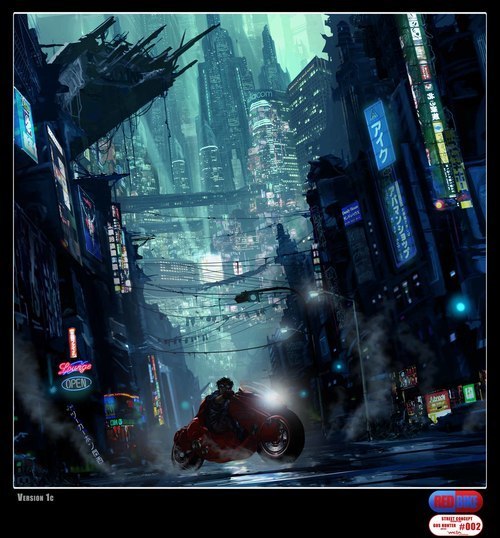
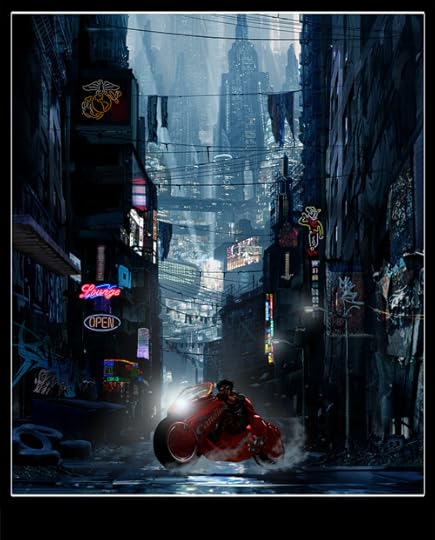



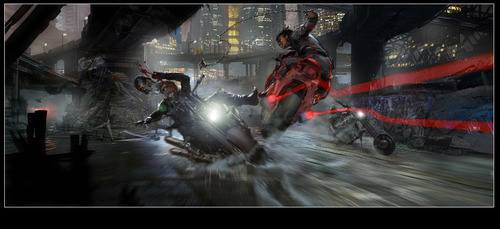
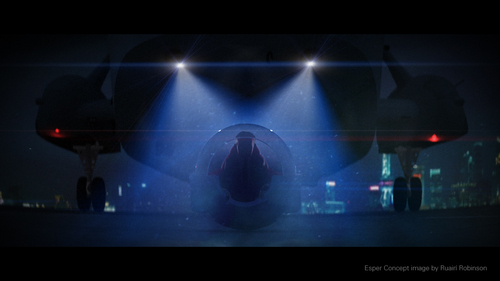 But what montage of Akira-related images would be complete without scenes depicting the unleashed psychic Tetsuo, demonstrated his newfound powers? Below are a couple that demonstrate the anime’s antagonist in action, in the first, deflecting a missile attack from an attack chopper, and in the second breaking into the Akira vault and discovering the namesake’s remains.
But what montage of Akira-related images would be complete without scenes depicting the unleashed psychic Tetsuo, demonstrated his newfound powers? Below are a couple that demonstrate the anime’s antagonist in action, in the first, deflecting a missile attack from an attack chopper, and in the second breaking into the Akira vault and discovering the namesake’s remains.
[image error]
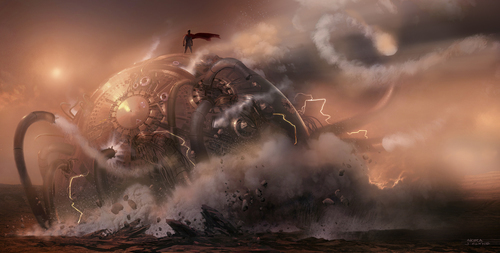 Not too bad to look at. But with the supposed director, producers, and actors changing every few years, many are wondering if this live-action remake will ever happen. And many fans can see nothing wrong with the idea, provided it is true to the source material. And dropping the whole Americanized angle and setting it back in Neo-Tokyo where it belongs wouldn’t hurt much either! But in the end, it really comes down to being true to the spirit of the Manga, if not the precise format.
Not too bad to look at. But with the supposed director, producers, and actors changing every few years, many are wondering if this live-action remake will ever happen. And many fans can see nothing wrong with the idea, provided it is true to the source material. And dropping the whole Americanized angle and setting it back in Neo-Tokyo where it belongs wouldn’t hurt much either! But in the end, it really comes down to being true to the spirit of the Manga, if not the precise format.
Luckily, there is still the crowdfunded live-action Akira Project. This fan-based effort to make an adaptation that is both true to the spirit and setting of the original manga produced a full-length teaser trailer not that long ago that impressed fans quite a bit! So who knows? If Hollywood can’t get its act together and make a decent remake, there’s always the direction and the funding of dedicated fans to pick up the slack! Time will tell which of them will bear fruit…
In the meantime, here’s another look at the Akira Project trailer:
Sources: moviepilot.com, ruairi-robinson.squarespace.com


Revolution in Virtual Reality: Google’s Cardboard Headset
 With the acquisition of the Oculus Rift headset, Facebook appeared ready to corner the market of the new virtual reality market. But at its annual I/O conference, Google declared that it was staking its own claim. At the end of the search giant’s keynote address, Sundar Pichai announced that everyone in attendance would get a nondescript cardboard package, but was coy about its contents. Turns out, it’s the firm’s attempt at a do-it-yourself VR headset.
With the acquisition of the Oculus Rift headset, Facebook appeared ready to corner the market of the new virtual reality market. But at its annual I/O conference, Google declared that it was staking its own claim. At the end of the search giant’s keynote address, Sundar Pichai announced that everyone in attendance would get a nondescript cardboard package, but was coy about its contents. Turns out, it’s the firm’s attempt at a do-it-yourself VR headset.
Known as Cardboard, copies of the headset were handed out as part of a goodie bag, alongside the choice between a brand new LG G Watch or Samsung Gear Live smartwatch. Intended to be a do-it-yourself starter kit, Google Cardboard is a head-mounted housing unit for your smartphone that lets you blend everyday items into a VR headset. With a $10 lens kit, $7 worth of magnets, two Velcro straps, a rubber band, and an optional near-field communication sticker tag, you can have your very own VR headset for the fraction of the price.
 You can use household materials to build one, and a rubber band to hold your smartphone in place on the front of the device. Assembly instructions, plans and links for where to source the needed parts (like lenses) — as well as an SDK — are available on the project’s website. Google hopes that by making the tech inexpensive (unlike offerings from, say, Oculus), developers will be able to make VR apps that hit a wider audience.
You can use household materials to build one, and a rubber band to hold your smartphone in place on the front of the device. Assembly instructions, plans and links for where to source the needed parts (like lenses) — as well as an SDK — are available on the project’s website. Google hopes that by making the tech inexpensive (unlike offerings from, say, Oculus), developers will be able to make VR apps that hit a wider audience.
According to some early reviews, the entire virtual reality experience is surprisingly intuitive, and is as impressive considering how simple it is. And while the quality doesn’t quite match the Oculus Rift’s dual OLED Full HD screens, and it is lacking in that it doesn’t have positional tracking (meaning you can’t lean into something the way you would in real life), the Cardboard is able to create the 3D effect using just a single phone screen and some specialized lenses.
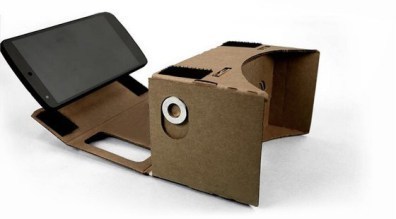 Meanwhile, Google has created some great demos within the Cardboard app, showcasing the kind of experiences people can expect moving forward. Right now, the Cardboard app features simple demonstrations: Google Earth, Street View, Windy Day, and more. But it’s just a small taste of what’s possible. And anyone willing to put some time into putting together their own cardboard headset can get involved. Never before has virtual reality been so accessible, or cheap.
Meanwhile, Google has created some great demos within the Cardboard app, showcasing the kind of experiences people can expect moving forward. Right now, the Cardboard app features simple demonstrations: Google Earth, Street View, Windy Day, and more. But it’s just a small taste of what’s possible. And anyone willing to put some time into putting together their own cardboard headset can get involved. Never before has virtual reality been so accessible, or cheap.
And that was precisely the purpose behind the development of this device. Originally concocted by David Coz and Damien Henry at the Google Cultural Institute in Paris as part of the company’s “20 percent time” initiative, the program was started with the aim of inspiring a more low-cost model for VR development. After an early prototype wowed Googlers, a larger group was tasked with building out the idea, and the current Cardboard headset was born.
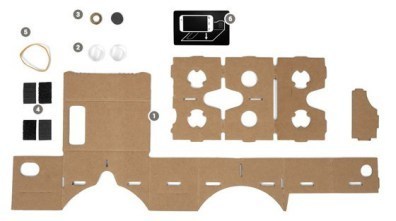 As it reads on Google’s new page for the device’s development:
As it reads on Google’s new page for the device’s development:
Virtual reality has made exciting progress over the past several years. However, developing for VR still requires expensive, specialized hardware. Thinking about how to make VR accessible to more people, a group of VR enthusiasts at Google experimented with using a smartphone to drive VR experiences.
Beyond hardware, on June 25th, the company also released a self-described experimental software development kit for Cardboard experiences. Cardboard also has an Android companion app that’s required to utilize Google’s own VR-specific applications, called Chrome Experiments. Some use cases Google cites now are flyover tours in Google Earth, full-screen YouTube video viewing, and first-person art exhibit tours.
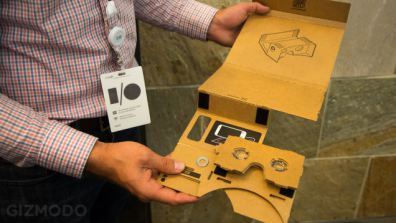 As Google said a related press release:
As Google said a related press release:
By making it easy and inexpensive to experiment with VR, we hope to encourage developers to build the next generation of immersive digital experiences and make them available to everyone.
Oculus Rift is still the most promising version of virtual reality right now, and with Facebook at the helm, there are some tremendous resources behind the project. But with Cardboard, Google is opening up VR to every single Android developer, which we hope will lead to some really awesome stuff down the road. Even if you can’t lean in to inspect dials in front of you, or look behind corners, the potential of Cardboard is tremendous. Imagine the kind of not only experiences we’ll see, but augmented reality using your phone’s camera.
But Cardboard is still very early in development. Its only been a few weeks since it was debuted at Google I/O, and the device is still only works with Android. But with availability on such a wide scale, it could very quickly become the go-to VR platform out there. All you need are some magnets, velcro, rubber band, lenses and a pizza box. And be sure to check out this demo of the device, courtesy of “Hands-On” by TechnoBuffalo:
Sources: cnet.com, technobuffalo.com, engadget.com


July 4, 2014
The Future of Devices: The Wearable Tech Boom
 The wearable computing revolution that has been taking place in recent years has drawn in developers and tech giants from all over the world. Though its roots are deep, dating back to the late 60′s and early 80′s with the Sword of Damocles concept and the work of Steve Mann. But in recent years, thanks to the development of Google Glass, the case for wearable tech has moved beyond hobbyists and enthusiasts and into the mainstream.
The wearable computing revolution that has been taking place in recent years has drawn in developers and tech giants from all over the world. Though its roots are deep, dating back to the late 60′s and early 80′s with the Sword of Damocles concept and the work of Steve Mann. But in recent years, thanks to the development of Google Glass, the case for wearable tech has moved beyond hobbyists and enthusiasts and into the mainstream.
And with display glasses now accounted for, the latest boom in development appears to be centered on smart watches and similar devices. These range from fitness trackers with just a few features to wrist-mounted version of smart phones that boast the same constellations of functions and apps (email, phone, text, skyping, etc.) And as always, the big-name industries are coming forward with their own concepts and designs.
 First, there’s the much-anticipated Apple iWatch, which is still in the rumor stage. The company has been working on this project since late 2012, but has begun accelerating the process as it tries to expand its family of mobile devices to the wrist. Apple has already started work on trademarking the name in a number of countries in preparation for a late 2014 launch perhaps in October, with the device entering mass production in July.
First, there’s the much-anticipated Apple iWatch, which is still in the rumor stage. The company has been working on this project since late 2012, but has begun accelerating the process as it tries to expand its family of mobile devices to the wrist. Apple has already started work on trademarking the name in a number of countries in preparation for a late 2014 launch perhaps in October, with the device entering mass production in July.
And though it’s not yet clear what the device will look like, several mockups and proposals have been leaked. And recent reports from sources like Reuters and The Wall Street Journal have pointed towards multiple screen sizes and price points, suggesting an array of different band and face options in various materials to position it as a fashion accessory. It is also expected to include a durable sapphire crystal display, produced in collaboration with Apple partner GT Advanced.
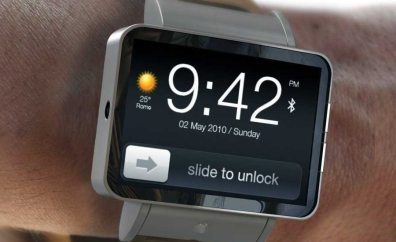 While the iWatch will perform some tasks independently using the new iOS 8 platform, it will be dependent on a compatible iOS device for functions like receiving messages, voice calls, and notifications. It is also expected to feature wireless charging capabilities, advanced mapping abilities, and possibly near-field communication (NFC) integration. But an added bonus, as indicated by Apple’s recent filing for patents associated with their “Health” app, is the inclusion of biometric and health sensors.
While the iWatch will perform some tasks independently using the new iOS 8 platform, it will be dependent on a compatible iOS device for functions like receiving messages, voice calls, and notifications. It is also expected to feature wireless charging capabilities, advanced mapping abilities, and possibly near-field communication (NFC) integration. But an added bonus, as indicated by Apple’s recent filing for patents associated with their “Health” app, is the inclusion of biometric and health sensors.
Along with serving as a companion device to the iPhone and iPad, the iWatch will be able to measure multiple different health-related metrics. Consistent with the features of a fitness band, these will things like a pedometer, calories burned, sleep quality, heart rate, and more. The iWatch is said to include 10 different sensors to track health and fitness, providing an overall picture of health and making the health-tracking experience more accessible to the general public.
 Apple has reportedly designed iOS 8 with the iWatch in mind, and the two are said to be heavily reliant on one another. The iWatch will likely take advantage of the “Health” app introduced with iOS 8, which may display all of the health-related information gathered by the watch. Currently, Apple is gearing up to begin mass production on the iWatch, and has been testing the device’s fitness capabilities with professional athletes such as Kobe Bryant, who will likely go on to promote the iWatch following its release.
Apple has reportedly designed iOS 8 with the iWatch in mind, and the two are said to be heavily reliant on one another. The iWatch will likely take advantage of the “Health” app introduced with iOS 8, which may display all of the health-related information gathered by the watch. Currently, Apple is gearing up to begin mass production on the iWatch, and has been testing the device’s fitness capabilities with professional athletes such as Kobe Bryant, who will likely go on to promote the iWatch following its release.
Not to be outdone, Google launched its own brand of smartwatch – known as Android Wear – at this year’s I/O conference. Android Wear is the company’s software platform for linking smartwatches from companies including LG, Samsung and Motorola to Android phones and tablets. A preview of Wear was introduced this spring, the I/O conference provided more details on how it will work and made it clear that the company is investing heavily in the notion that wearables are the future.
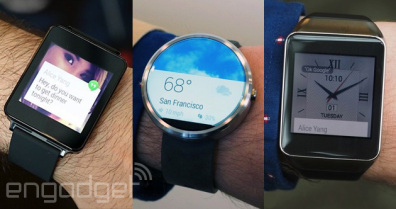 Android Wear takes much of the functionality of Google Now – an intelligent personal assistant – and uses the smartwatch as a home for receiving notifications and context-based information. For the sake of travel, Android Wear will push relevant flight, weather and other information directly to the watch, where the user can tap and swipe their way through it and use embedded prompts and voice control to take further actions, like dictating a note with reminders to pack rain gear.
Android Wear takes much of the functionality of Google Now – an intelligent personal assistant – and uses the smartwatch as a home for receiving notifications and context-based information. For the sake of travel, Android Wear will push relevant flight, weather and other information directly to the watch, where the user can tap and swipe their way through it and use embedded prompts and voice control to take further actions, like dictating a note with reminders to pack rain gear.
For the most part, Google had already revealed most of what Wear will be able to do in its preview, but its big on-stage debut at I/O was largely about getting app developers to buy into the platform and keep designing for a peripheral wearable interface in mind. Apps can be designed to harness different Android Wear “intents.” For example, the Lyft app takes advantage of the “call me a car” intent and can be set to be the default means of hailing a ride when you tell your smartwatch to find you a car.
 Google officials also claimed at I/O that the same interface being Android Wear will be behind their new Android Auto and TV, two other integrated services that allow users to interface with their car and television via a mobile device. So don’t be surprised if you see someone unlocking or starting their car by talking into their watch in the near future. The first Android Wear watches – the Samsung Gear Live and the LG G Watch – are available to pre-order and the round-face Motorola Moto 360 is expected to come out later this summer.
Google officials also claimed at I/O that the same interface being Android Wear will be behind their new Android Auto and TV, two other integrated services that allow users to interface with their car and television via a mobile device. So don’t be surprised if you see someone unlocking or starting their car by talking into their watch in the near future. The first Android Wear watches – the Samsung Gear Live and the LG G Watch – are available to pre-order and the round-face Motorola Moto 360 is expected to come out later this summer.
All of these steps in integration and wearable technology are signs of an emergent trend, one where just about everything from personal devices to automobiles and even homes are smart and networked together – thus giving rise to a world where everything is remotely accessible. This concept, otherwise known as the “Internet of Things”, is expected to become the norm in the next 20 years, and will include other technologies like display contacts and mediated (aka. augmented) reality.
And be sure to check out this concept video of the Apple iWatch:
Sources: cnet.com, (2), macrumors.com, engadget.com, gizmag.com


July 3, 2014
Climate Crisis: China’s Pollution-Eating Skyscrapers
 Though it is already home to the world’s largest building – in the form of the New Century Global Center in Chendu – China is seeking to create the world’s tallest structure as well. Designed by UK-based Chetwoods Architects and known as the Phoenix Towers, this tower concept is slated to be built in Wuhan, Central China. But equally impressive is the fact that this building will be suck pollution out of the air and water and will host more than the usual building features.
Though it is already home to the world’s largest building – in the form of the New Century Global Center in Chendu – China is seeking to create the world’s tallest structure as well. Designed by UK-based Chetwoods Architects and known as the Phoenix Towers, this tower concept is slated to be built in Wuhan, Central China. But equally impressive is the fact that this building will be suck pollution out of the air and water and will host more than the usual building features.
The larger of the two towers reaches a total of 1000 meters (3,280 ft) in height – beating the Burj Khalifa by 170 meters (558 ft) – and sports an ambitious list of sustainable technology. The towers cover 7 hectares (17 acres) of ground on a 47-hectare (116-acre) plot that sits upon an island in a lake. In an attempt to make the design of the towers more relevant to Chinese culture, Chetwoods drew upon the Fenghuang (or Chinese Phoenix) mythological bird and designated the larger tower Feng (male), and the smaller tower Huang (female).
 The designers hope the building will serve as a catalyst for more sustainable design in the industrial city. Laurie Chetwood, chairman of U.K.-based Chetwoods, the architects on the project explained how the building’s water-cleaning features work:
The designers hope the building will serve as a catalyst for more sustainable design in the industrial city. Laurie Chetwood, chairman of U.K.-based Chetwoods, the architects on the project explained how the building’s water-cleaning features work:
The water goes up through a series of filters. We don’t use power to pull the water up, we’re using passive energy. As it goes through the filters and back, we’re also putting air back into the lake to make it healthier… Wuhan is an unusual city, dotted with huge lakes. Protecting the lakes could lead to other projects that protect them even more.
The towers also have pollution-absorbing coatings to help clean the air, vertical gardens that filter more pollution, and a chimney in the middle of the larger tower naturally pulls air across the lake for better ventilation. For the sake of generating energy, the building relies on a combination of wind turbines, lightweight solar cladding, and hydrogen fuel cells running on the buildings’ waste, giving it energy independence and even having enough left over for the local community.
 Inspired by the Chinese symbols of the phoenix, and the concept of yin and yang, one tower feeds the other with renewable power in a symbiotic relationship. Spheres hanging between the two towers will also hold restaurants with views of the lake. Pending approval by the city’s mayor, construction may begin by the end of the year and could be completed by 2017 or 2018, a pace that the architects say would be unlikely in other countries.
Inspired by the Chinese symbols of the phoenix, and the concept of yin and yang, one tower feeds the other with renewable power in a symbiotic relationship. Spheres hanging between the two towers will also hold restaurants with views of the lake. Pending approval by the city’s mayor, construction may begin by the end of the year and could be completed by 2017 or 2018, a pace that the architects say would be unlikely in other countries.
According to Chetwood, construction in China obeys a different set of rules and parameters than his native Britain:
The most amazing thing for me is that in the U.K. we strive as designers to get things built, and there’s a lot of red tape, but the Chinese seem to have a different view of things. I think they’re incredibly optimistic. If you have an idea and you think, ‘Oh, is this going to be too exciting’, they’ll actually want it more exciting. It’s more ambitious. They’re quite keen to push the boundaries. For a designer, that’s fantastic. It’s a thrill.
Whereas the sheer size of the buildings is reflective of China’s aim to assert its national authority on the world stage, it’s focus on pollution-eating and green energy is reflective of the desire to create living spaces in a sustainable way. And it is one of many building concepts being considered by Chinese authorities that seeks to address pollution by achieve energy independence, while at the same time being part of the solution by incorporating pollution-eating features.
 For instance, there’s China’s Shanghai Tower, which finished construction in August of last year. This building is currently the tallest tower in China, is one-third green space and a transparent second skin that surrounds the city in a protective air envelope that controls its internal temperature. In addition, vertical-axis wind turbines located near the top of the tower and geothermal vents located at the bottom will generate 350,000 kWh of supplementary electricity per year.
For instance, there’s China’s Shanghai Tower, which finished construction in August of last year. This building is currently the tallest tower in China, is one-third green space and a transparent second skin that surrounds the city in a protective air envelope that controls its internal temperature. In addition, vertical-axis wind turbines located near the top of the tower and geothermal vents located at the bottom will generate 350,000 kWh of supplementary electricity per year.
And then there’s Sky City, a building under construction (though currently on hold) in Changsha, Hunan province. Designed by Broad Sustainable Building, this 666m meter (2,185 ft) skyscraper incorporates numerous sustainable building features. These include modular design, recycled building materials, non-toxic building materials, insulated walls and quadruple glazing. Beyond China, there is also the Pertamina Energy Tower in Jakarta, which relies on geothermal, solar, and wind turbines to act as the very picture of energy independence.
Together, these concepts (and many others currently under consideration) represent the future of urban planning and architecture. In addition to being assembled with recycled material, fabricated using less wasteful methods (like 3-D printing), and seeing to their own energy needs in a clean and sustainable way, they will also incorporate carbon capture, air and water cleaning technology that will make urban environments healthier places to live.
Sources: fastcoexist.com, designboom.com, gizmag.com


Climate Crisis: Pollution-Eating Skyscrapers will be World’s Tallest
 Though it is already home to the world’s largest building – in the form of the New Century Global Center in Chendu – China is seeking to create the world’s tallest structure as well. Designed by UK-based Chetwoods Architects and known as the Phoenix Towers, this tower concept is slated to be built in Wuhan, Central China. But equally impressive is the fact that this building will be suck pollution out of the air and water and will host more than the usual building features.
Though it is already home to the world’s largest building – in the form of the New Century Global Center in Chendu – China is seeking to create the world’s tallest structure as well. Designed by UK-based Chetwoods Architects and known as the Phoenix Towers, this tower concept is slated to be built in Wuhan, Central China. But equally impressive is the fact that this building will be suck pollution out of the air and water and will host more than the usual building features.
The larger of the two towers reaches a total of 1000 meters (3,280 ft) in height – beating the Burj Khalifa by 170 meters (558 ft) – and sports an ambitious list of sustainable technology. The towers cover 7 hectares (17 acres) of ground on a 47-hectare (116-acre) plot that sits upon an island in a lake. In an attempt to make the design of the towers more relevant to Chinese culture, Chetwoods drew upon the Fenghuang (or Chinese Phoenix) mythological bird and designated the larger tower Feng (male), and the smaller tower Huang (female).
 The designers hope the building will serve as a catalyst for more sustainable design in the industrial city. Laurie Chetwood, chairman of U.K.-based Chetwoods, the architects on the project explained how the building’s water-cleaning features work:
The designers hope the building will serve as a catalyst for more sustainable design in the industrial city. Laurie Chetwood, chairman of U.K.-based Chetwoods, the architects on the project explained how the building’s water-cleaning features work:
The water goes up through a series of filters. We don’t use power to pull the water up, we’re using passive energy. As it goes through the filters and back, we’re also putting air back into the lake to make it healthier… Wuhan is an unusual city, dotted with huge lakes. Protecting the lakes could lead to other projects that protect them even more.
The towers also have pollution-absorbing coatings to help clean the air, vertical gardens that filter more pollution, and a chimney in the middle of the larger tower naturally pulls air across the lake for better ventilation. For the sake of generating energy, the building relies on a combination of wind turbines, lightweight solar cladding, and hydrogen fuel cells running on the buildings’ waste, giving it energy independence and even having enough left over for the local community.
 Inspired by the Chinese symbols of the phoenix, and the concept of yin and yang, one tower feeds the other with renewable power in a symbiotic relationship. Spheres hanging between the two towers will also hold restaurants with views of the lake. Pending approval by the city’s mayor, construction may begin by the end of the year and could be completed by 2017 or 2018, a pace that the architects say would be unlikely in other countries.
Inspired by the Chinese symbols of the phoenix, and the concept of yin and yang, one tower feeds the other with renewable power in a symbiotic relationship. Spheres hanging between the two towers will also hold restaurants with views of the lake. Pending approval by the city’s mayor, construction may begin by the end of the year and could be completed by 2017 or 2018, a pace that the architects say would be unlikely in other countries.
According to Chetwood, construction in China obeys a different set of rules and parameters than his native Britain:
The most amazing thing for me is that in the U.K. we strive as designers to get things built, and there’s a lot of red tape, but the Chinese seem to have a different view of things. I think they’re incredibly optimistic. If you have an idea and you think, ‘Oh, is this going to be too exciting’, they’ll actually want it more exciting. It’s more ambitious. They’re quite keen to push the boundaries. For a designer, that’s fantastic. It’s a thrill.
Whereas the sheer size of the buildings is reflective of China’s aim to assert its national authority on the world stage, it’s focus on pollution-eating and green energy is reflective of the desire to create living spaces in a sustainable way. And it is one of many building concepts being considered by Chinese authorities that seeks to address pollution by achieve energy independence, while at the same time being part of the solution by incorporating pollution-eating features.
 For instance, there’s China’s Shanghai Tower, which finished construction in August of last year. This building is currently the tallest tower in China, is one-third green space and a transparent second skin that surrounds the city in a protective air envelope that controls its internal temperature. In addition, vertical-axis wind turbines located near the top of the tower and geothermal vents located at the bottom will generate 350,000 kWh of supplementary electricity per year.
For instance, there’s China’s Shanghai Tower, which finished construction in August of last year. This building is currently the tallest tower in China, is one-third green space and a transparent second skin that surrounds the city in a protective air envelope that controls its internal temperature. In addition, vertical-axis wind turbines located near the top of the tower and geothermal vents located at the bottom will generate 350,000 kWh of supplementary electricity per year.
And then there’s Sky City, a building under construction (though currently on hold) in Changsha, Hunan province. Designed by Broad Sustainable Building, this 666m meter (2,185 ft) skyscraper incorporates numerous sustainable building features. These include modular design, recycled building materials, non-toxic building materials, insulated walls and quadruple glazing. Beyond China, there is also the Pertamina Energy Tower in Jakarta, which relies on geothermal, solar, and wind turbines to act as the very picture of energy independence.
Together, these concepts (and many others currently under consideration) represent the future of urban planning and architecture. In addition to being assembled with recycled material, fabricated using less wasteful methods (like 3-D printing), and seeing to their own energy needs in a clean and sustainable way, they will also incorporate carbon capture, air and water cleaning technology that will make urban environments healthier places to live.
Sources: fastcoexist.com, designboom.com, gizmag.com


Immortality Inc: Google’s Kurzweil Talks Life Extension
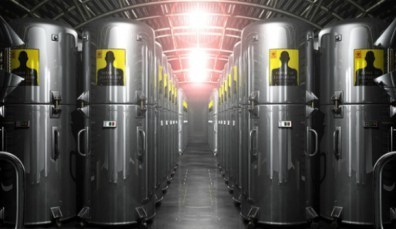 Human life expectancy has been gradually getting longer and longer over the past century, keeping pace with advances made in health and medical technologies. And in the next 20 years, as the pace of technological change accelerates significantly, we can expect life-expectancy to undergo a similarly accelerated increase. So its only natural that one of the worlds biggest tech giants (Google) would decide to becoming invested in the business of post-mortality.
Human life expectancy has been gradually getting longer and longer over the past century, keeping pace with advances made in health and medical technologies. And in the next 20 years, as the pace of technological change accelerates significantly, we can expect life-expectancy to undergo a similarly accelerated increase. So its only natural that one of the worlds biggest tech giants (Google) would decide to becoming invested in the business of post-mortality.
As part of this initiative, Google has been seeking to build a computer that can think like a human brain. They even hired renowed futurist and AI expert Ray Kurzweil last year to act as the director of engineering on this project. Speaking at Google’s I/O conference late last month, he detailed his prediction that our ability to improve human health is beginning to move up an “exponential” growth curve, similar to the law of accelerating returns that governs the information technology and communications sectors today.
 The capacity to sequence DNA, which is dropping rapidly in cost and ease, is the most obvious example. At one time, it took about seven years to sequence 1% of the first human genome. But now, it can be done in a matter of hours. And thanks to initiatives like the Human Genome Project and ENCODE, we have not only successfully mapped every inch of the human genome, we’ve also identified the function of every gene within.
The capacity to sequence DNA, which is dropping rapidly in cost and ease, is the most obvious example. At one time, it took about seven years to sequence 1% of the first human genome. But now, it can be done in a matter of hours. And thanks to initiatives like the Human Genome Project and ENCODE, we have not only successfully mapped every inch of the human genome, we’ve also identified the function of every gene within.
But as Kurzweil said in the course of his presentation – entitled “Biologically Inspired Models of Intelligence” – simply reading DNA is only the beginning:
Our ability to reprogram this outdated software is growing exponentially. Somewhere between that 10- and 20-year mark, we’ll see see significant differences in life expectancy–not just infant life expectancy, but your remaining life expectancy. The models that are used by life insurance companies sort of continue the linear progress we’ve made before health and medicine was an information technology… This is going to go into high gear.
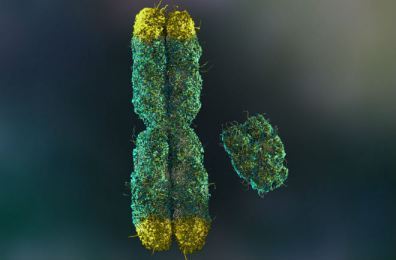 Kurzweil cited several examples of our increasing ability to “reprogram this outdated data” – technologies like RNA interference that can turn genes on and off, or doctors’ ability to now add a missing gene to patients with a terminal disease called pulmonary hypertension. He cited the case of a girl whose life was threatened by a damaged wind pipe, who had a new pipe designed and 3-D printed for her using her own stem cells.
Kurzweil cited several examples of our increasing ability to “reprogram this outdated data” – technologies like RNA interference that can turn genes on and off, or doctors’ ability to now add a missing gene to patients with a terminal disease called pulmonary hypertension. He cited the case of a girl whose life was threatened by a damaged wind pipe, who had a new pipe designed and 3-D printed for her using her own stem cells.
In other countries, he notes, heart attack survivors who have lasting heart damage can now get a rejuvenated heart from reprogrammed stem cells. And while this procedure awaits approval from the FDA in the US, it has already been demonstrated to be both safe and effective. Beyond tweaking human biology through DNA/RNA reprogramming, there are also countless initiatives aimed at creating biomonitoring patches that will improve the functionality and longevity of human organs.
 And in addition to building computer brains, Google itself is also in the business of extending human life. This project, called Calico, hopes to slow the process of natural aging, a related though different goal than extending life expectancy with treatment for disease. Though of course, the term “immortality” is perhaps a bit of misnomer, hence why it is amended with the word “clinical”. While the natural effects of aging are something that can be addressed, there will still be countless ways to die.
And in addition to building computer brains, Google itself is also in the business of extending human life. This project, called Calico, hopes to slow the process of natural aging, a related though different goal than extending life expectancy with treatment for disease. Though of course, the term “immortality” is perhaps a bit of misnomer, hence why it is amended with the word “clinical”. While the natural effects of aging are something that can be addressed, there will still be countless ways to die.
As Kurzweil himself put it:
Life expectancy is a statistical phenomenon. You could still be hit by the proverbial bus tomorrow. Of course, we’re working on that here at Google also, with self-driving cars.
Good one, Kurzweil! Of course, there are plenty of skeptics who question the validity of these assertions, and challenge the notion of clinical immortality on ethical grounds. After all, our planet currently plays host to some 7 billion people, and another 2 to 3 billion are expected to be added before we reach the halfway mark of this century. And with cures for diseases like HIV and cancer already showing promise, we may already be looking at a severe drop in mortality in the coming decades.
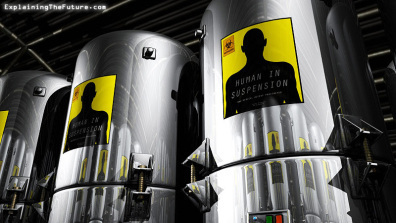 Combined with an extension in life-expectancy, who knows how this will effect life and society as we know it? But one thing is for certain: the study of life has become tantamount to a study of information. And much like computational technology, this information can be manipulated, resulting in greater performance and returns. So at this point, regardless of whether or not it should be done, it’s an almost foregone conclusion that it will be done.
Combined with an extension in life-expectancy, who knows how this will effect life and society as we know it? But one thing is for certain: the study of life has become tantamount to a study of information. And much like computational technology, this information can be manipulated, resulting in greater performance and returns. So at this point, regardless of whether or not it should be done, it’s an almost foregone conclusion that it will be done.
After all? While very few people would dare to live forever, there is virtually no one who wouldn’t want to live a little longer. And in the meantime, if you’ve got the time and feel like some “light veiwing”, be sure to check out Kurzweil’s full Google I/O 2014 speech in which he addresses the topics of computing, artificial intelligence, biology and clinical immortality:
Sources: fastcoexist.com, kurzweilai.net






